< home < content next: part 5 >
RIMMA GERLOVINA
THE CUBES
© 2010, Rimma Gerlovina and Valeriy Gerlovin
PART 4
The very first cube Quintessence virtually has to be the last one. As such and also as the corner stone, it is depicted in the wall-poem called, Icon (1974). Twenty conceptual scenes of that icon unfold into a biography of a person, whose image is supposed to occupy the center of the composition. The central place is left empty, signifying that it is reserved not for one particular individual, but for the archetype. In the hagiographic structure of the icon, each cell suits the corresponding coded level of consciousness. This pictographic biography is kept within one opus circulatorum, which has many layers and rounds, but one uniting center. The idea of the progressive opening of the consciousness develops like a child that has to aggregate his parts in the womb until the moment when he is ready to "jump out." The motive of the introverted quintessence becomes a refrain in the last cells, whose interiors are progressively covered out of the view. Finally, when opening the last cell of the Icon, one can see that it does not have a back wall; its frontal lid covers the mystery of abyss - the grave is empty.
![]()
Rimma
Gerlovina, Icon: The cells code an archetypal destiny of a man. 1974,
cardboard, wood, paper, acrylic, 19¼ x 18½ x 3". Collection of
Zimmerli Art Museum, Rutgers University, NJ (link). |
1. Appearance (the empty white cube); 2. First impressions ("Who is here?"); 3. Сhildhood (4 small cubes: "ice cream," "dead granny," "window to the garden," "white hospital"); 4. Initial understanding ("this" or "that"); 5. Big Love; 6. Receipt of information; 7. Full of information; 8. False orientation as a result of it (wrong compass); 9. Dualism ("that's the point" and "that's not the point"); 10. Division ("for me," "for you," "for us," "for them"); 11. Home ("toilet," "kitchen," "rooms," "poster"); 12. Accumulation ("the more is the more"); 13. Black hole or shock; 14. After the shock or half black hole ("see next"); 15. Liberation from information (symmetrical to cell #6); 16. Memories of childhood ("white hospital" and "dead granny" are gray now); 17. Concentration or Quintessence ("under me" is on the bottom and "in front of me" on the four sides around); 18. The same but half closed; 19. Fully closed; 20. Exit. (The lid can be opened. The cube is bottomless.) |
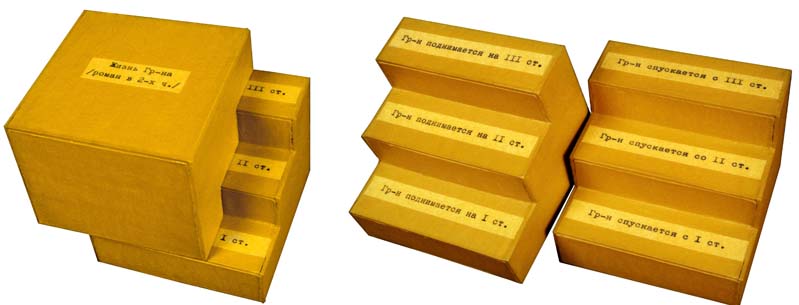
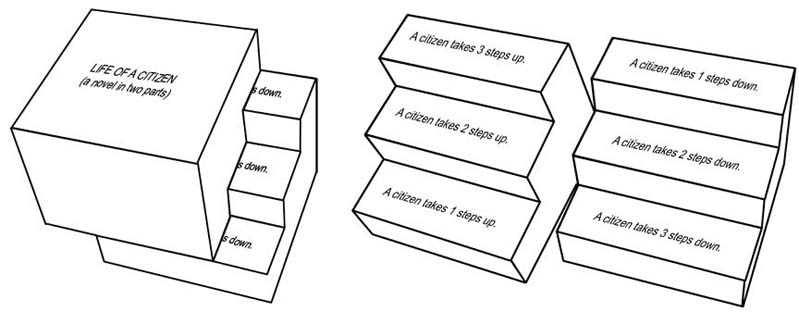
Rimma Gerlovina, Life
of a Citizen (Novel in Two Parts): The cube consists of two step
halves; one of them reads in the following sequence: "A citizen takes one step
up," "two steps up," "three steps up". The other half is labeled
correspondingly: "A citizen takes one step down," "two steps down," "three steps down." 1974, cardboard, paper, acrylic, 3¼ x 3¼ x
3¼". |
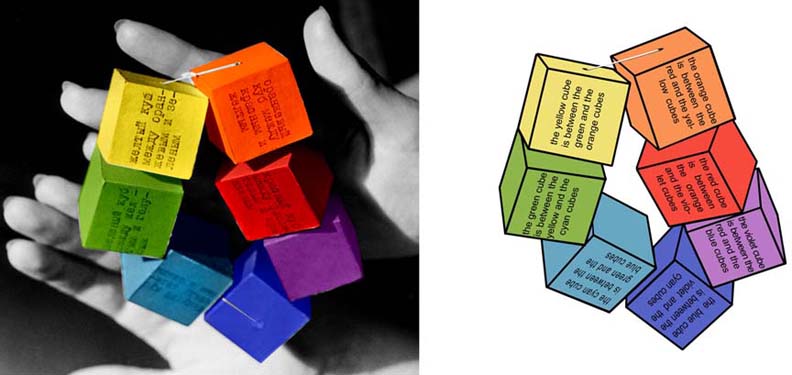
Rimma
Gerlovina, Rosaries: Seven cubes are connected in a spectral sequence.
1976, wood, paper, each cube is 1¼ x 1¼ x 1¼". |

Gerlovina, Dices: Absolute Fortune and Absolute Misfortune. 1976, wood,
paper, 1¼ x 1¼ x 1¼". |
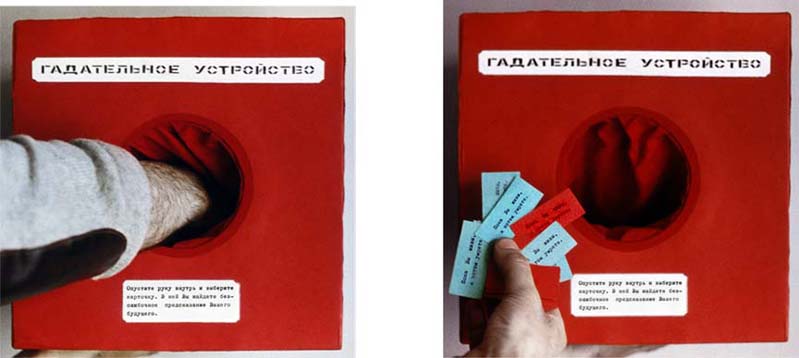
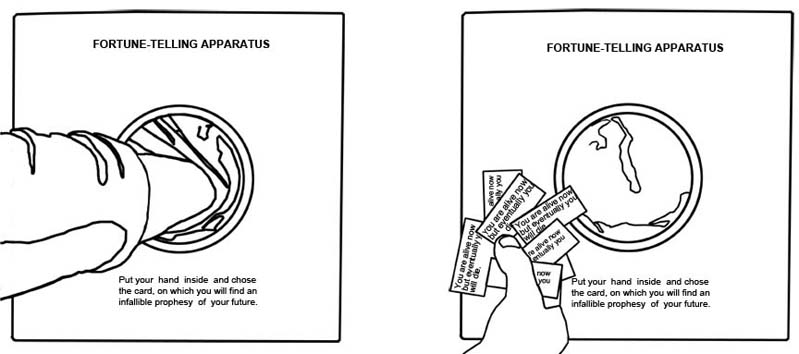
Rimma Gerlovina, Fortune-Telling Apparatus: "Put your
hand inside and chose the card, on which you will find an infallible prophesy
of your future" is written on the box, while each card inside reads: "You are
alive now but eventually you will die." Below, the work is shown from aside.
1975, cardboard, fabric, paper, 11¾ x 11¾ x 11¾". |
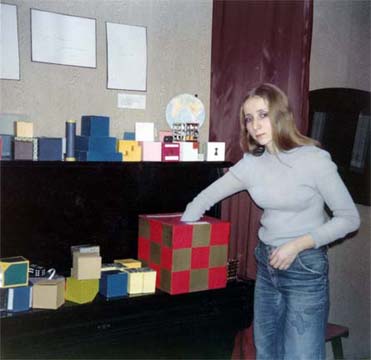
Rimma Gerlovina with Fortune-Telling Apparatus, 1975, Moscow.
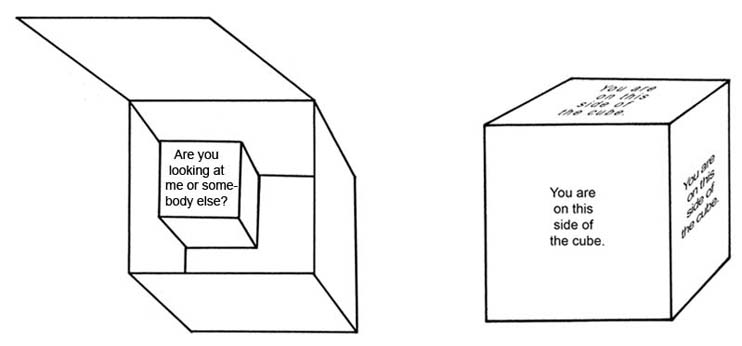
Rimma
Gerlovina, Are You Looking at Me or Somebody Else? 2009 and You
Are on This Side of the Cube, 1974. |

Rimma Gerlovina, Everybody Thinks That ItŐs a Cube, 1975, cardboard, paper, acrylic, 3¼ x 3¼ x 3¼".
In a whole, the process of opening of consciousness might be compared to the work of a sculptor. In the beginning, a sculpture exists only in the head of its author, because in physical reality, it is merely a piece of stone. The image gradually appears after cutting out layers of what is "extra" to it, piece by piece, one "inferior" element after another, until only the essential, or rather, the quintessential remains. Some cubes play on parodies of different atavistic elements; others operate with more complicated ideas, presenting a variety of analytical knots that are done and consequently undone. The works set a limit on the information that pop up out of the boxes as laconic simile, extraordinary fact, or "shock-absorbing" joke. They play on paradoxes, speaking with metaphorical clarity, while also preserving their ambiguity. In short, the cubes maneuver not only with words, but also with sounds, thoughts, reticence, and even silence.
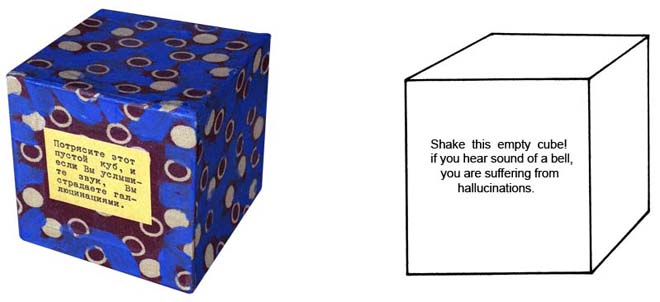
Rimma Gerlovina, The Bell, 1974, cardboard, bell, fabric, paper, 3¼ x
3¼ x 3¼". |

Rimma Gerlovina,Who Is There? 1974, cardboard, wood, paper, acrylic, 3¼ x 3¼ x 3¼". |
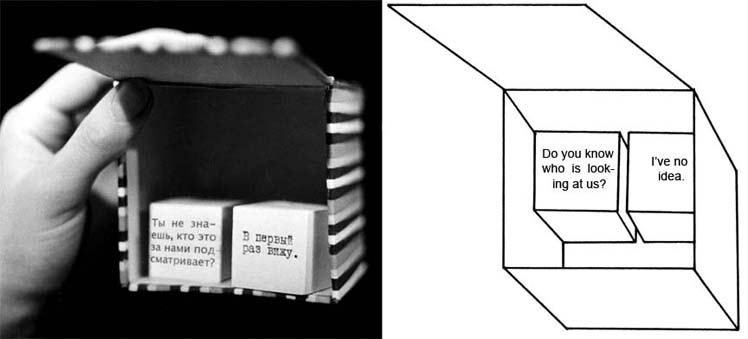
Rimma Gerlovina, Who Is Looking at Us? 1974, cardboard, wood, paper, acrylic, 3¼ x 3¼ x 3¼". |
Mimic Series


Rimma
Gerlovina, Mimic Series, three cubes with the photographs of Oleg Kiseljov
on the lid and inside the cubes, 1977. |
The list of content of some cubes and their clones is given below. It is worth mentioning that navigation in that catalog of their absurd "properties" requires a certain mental alertness, and perhaps, a sense of humor would not be out of place either.
Description of Some Cubes
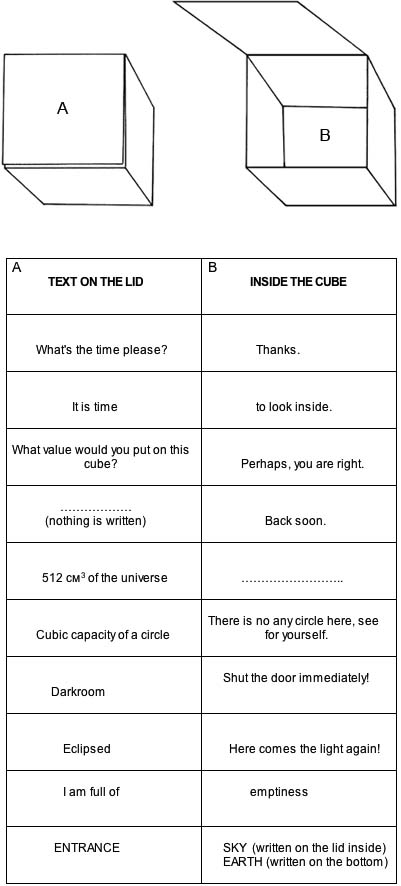

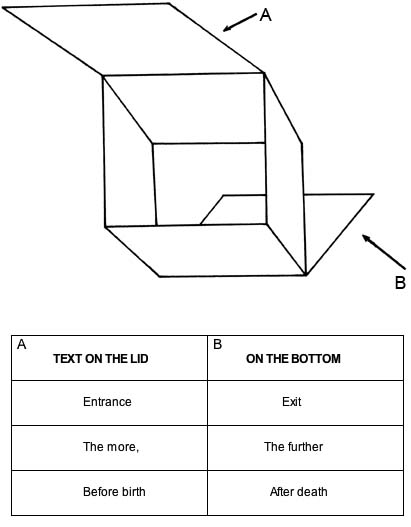
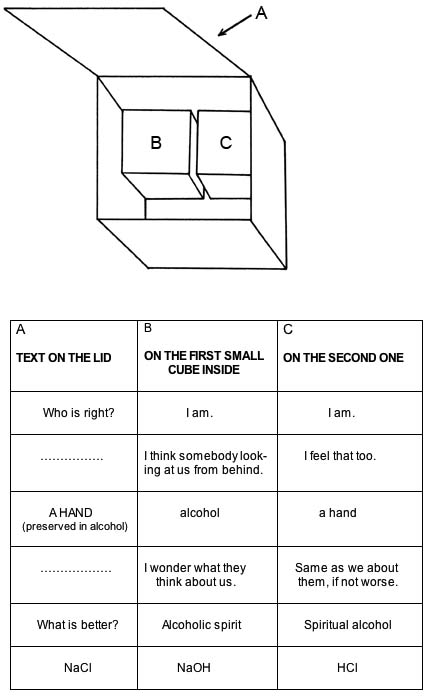
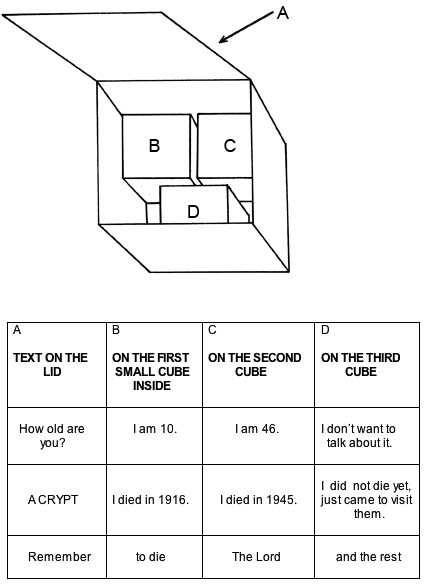
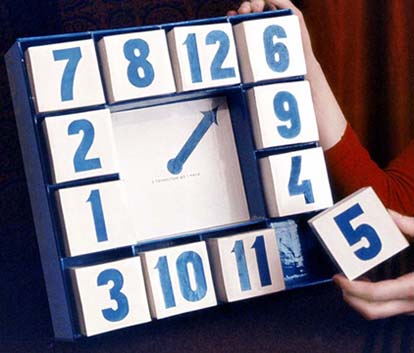
Rimma Gerlovina, A Clock. Accurate to within One Hour: The hour hand does not move, while the hours-cubes can be moved around the clock. 1975, mazonite,
cardboard, paper, 13 x 13 x 3¼". |
< home < content next: part 5 >